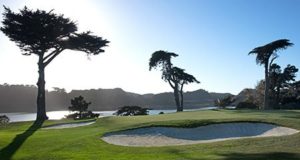
California golf conjures up fond reveries of golden sunshine, rhythmic waves lapping peacefully at rocky shorelines, and flagsticks snapping briskly in the breeze, silhouetted nobly against the blazing sunset…
…just not at TPC Harding Park.
Let’s see: Olympic Club, Meadow Club, California Golf Club of San Francisco, San Francisco Golf Club, Pebble Beach, both courses at Monterey Peninsula Country Club, Pasatiempo, Cypress Point, Spanish Bay, Spyglass Hill, Poppy Hills, Cordevalle – all of those are more interesting and prettier than Harding Park, and they are all within 75 minutes of San Francisco.
One major magazine recently rated Harding Park as only the 47th best course in California. It really makes you wonder – for the trillionth time – why can’t the PGA of America get out of their own way when it comes to picking venues for their flagship championship. We’re in Northern California, and they choose TPC Harding Park? Nobody else would have.
Typical of the homogenized golf that has become the hallmark of the TPC brand, Harding Park is nothing you haven’t seen before: straight-forward golf presented cleanly with no tricks, but no treats either. Not many strategic angles, bland greens, and no holes that stand out as exemplary – TPC Boring park as one irreverent wag once dubbed it. To illustrate this point, Your Author took an unscientific poll of ten experienced and respected golf writers what their favorite hole was at Harding Park. I got seven “I dunnos” and three “I don’t really have ones.” When pressed, they all agreed: the reason was that they didn’t remember the holes well. And you won’t either.
That’s not how it’s supposed to work at majors; at majors, the course is supposed to be the star. Harding Park, on the other hand, reminds me of an understudy who was elevated because the headliner just got news of a positive Coronavirus test and can’t leave the house for 14 days. In an ironic way, though, it’s no problem that this year the fans won’t see the Wanamaker Trophy presentation live because, just like when we go to Quail Hollow in North Carolina, they’ll all be playing better golf courses than the pros this week.
Even so, that doesn’t mean we won’t have an exciting tournament. Harding Park is short by modern standards – 7,234 yards with a par of 70. Therefore, there should be plenty of birdie ops, starting right out of the gate with number one.
The first hole is a straightway par-4 measuring a mere 393 yards. That’s a drive and a pitch for your average Tour player. Even with fairways narrowed to 22-23 yards wide, and three and a half inch rough, it’s a bomb and gauge hole. Similarly, the 340-yard par-4 seventh hole is also a drive and a pitch. That should get the field off to a good start.
Better still, the par-3s are tiny. Harding Park has two par-3s under 190 yards, a rarity nowadays. Even in cold air and marine layer, that’s a mid-to-short iron for the players. And even the 250-yard eighth pales in comparison to some of the gargantuan par-3s the PGA of America or USGA have thrown at the competitors in the past. (That 300-yard par-3 eighth hole at Oakmont in 2007 and 2016 and the 275 yard par-3 15th over water at Atlanta Athletic Club in 2011 are two egregious examples of how longer is not better….)
That’s not to say there aren’t any stern par-4s, there are. As two-time defending champion Brooks Koepka pointed out in his morning interview, at Harding “the short holes are short, but the long holes are long.” The par-4s at 13 and 14, both difficult driving holes, form the sturdy backbone of the homeward nine. At a stern 472 yards, the tee shot at 13 must also feature a slight fade at the end to have the best angle to the green, while any tee shot left on 14 may end up in a gully well below the level of the green, making the approach on this 470-yard hole semi-blind or worse.
“You have to drive the ball well this week. If you put the ball in the fairway out here, there’s a lot of long irons into these par-4s,” Koepka confirmed. “I hit three long irons on the back nine….but still at the same time, if you’re in that rough, there’s no chance you’re hitting 4- or 5-iron into these greens. You have to drive it well, and put it into the fairway…especially on the back.”
And of course there are also the ubiquitous two par-5s masquerading as par-4s for this tournament. At the 515-yard ninth, the key is to avoid the fairway bunkers on the right of the tee. The approach is into the green is straightforward; just don’t lose it short and left into a bunker or greenside swale. Similarly, the challenge at the 495 yard 12th, also a downgraded par-5, is to avoid the out-of-bounds left off the tee. Anything left will require a hard draw into the green, which brings greenside trouble short and right into play should the draw not materialize.
Still, the two par-5s that are on the card should be reasonable birdie ops with the potential for a few eagles as well. The 607-yard fourth dog-legs in an awkward place, so not many people should get home in two, but they should be close enough for a good look at an up-and-down birdie, while the 562-yard 10th should have the field chomping at the bit to pick up two strokes to par.
“Yeah…the 10th hole…I think I remember that one,” mumbled one of the ten golf writers I consulted in previewing the course.
Finally, at a diminutive 336 yards, the par-4 16th already plays a half-stroke easier to par, but with the certainty that at least on one day the tees will be moved forward, players may be enticed to drive the green and take a shot at a late round eagle.
Other than that, don’t double cross one into the water on 18 with the lead on Sunday, and there isn’t really much trouble that should give the players pause. Sure the players are being respectful of Kerry Haigh’s narrowed fairways (22-24 yards wide, narrowed on both sides) and thick, 3-1/2 inch rough, and yes, the rough has been mowed around the bunkers so that more balls will roll into them rather than in the grassy surrounds. But Harding just doesn’t have the teeth – either in the form of cunning greens or dangerous, iconic hazards – of an Oakmont, Winged Foot, or Oakland Hills. 12-under, not 2-under should win the Wanamaker Trophy.
Still, don’t tell that to Tiger Woods, who’s chanting doom and gloom…or is it just “June Gloom?”
“It’s going to be play longer; it’s heavy air. Whether the wind blows or not, the ball doesn’t fly very far here. I’ve known that from all the years and times I’ve had to qualify up in this area,” warned Woods. “This golf course in particular can be misleading. They have pinched in the fairways a little bit, and the rough is thick, it’s lush. With this marine layer here…it’s going to put a premium on getting the ball in play.”
We’d like to believe that, but with pro golfers’ drives exceeding 400 yards with what should be alarming frequency, nowadays rough or fairway does not matter, not if the trouble on the hole ends upon reaching the green. Driving accuracy no longer wins majors. Tom Meeks is long gone, packed off to Indiana. Now greens in regulation and putting win majors, and with Harding featuring so many short holes and flat greens, bomb and gauge may take the Wanamaker Trophy.
Meanwhile, we can all put our heads on our pillows tonight and dream about the dawning of the season’s first major. Now if only that dreamscape was California Golf Club of San Francisco, then we’d really be getting somewhere.





